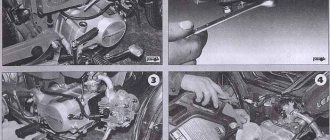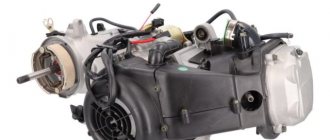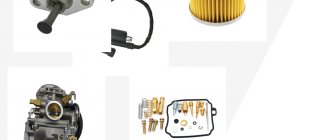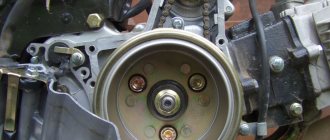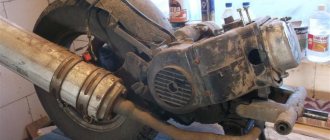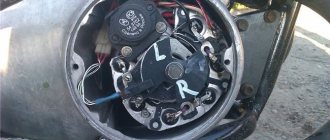Hi all.
Let's continue the topic of tech. maintenance of a 50cc scooter.
Last time we looked at the maintenance of the air filter, throttle cable and brakes. But this is not enough for the flawless operation of your motorcycle. An important point is the timely change of oil on the scooter.
Let's look in detail at when and how to carry out such work on 2t and 4t engines.
Necessity
During use of the scooter, metal dust accumulates in the oil, resulting from the wear and tear of engine parts. It changes the structure of the oil and worsens its properties. Low-quality motor oil is often found, characterized by sedimentation. In addition, over time, the consistency of the oil fluid changes, and other defects appear that have a detrimental effect on the scooter engine. The uninterrupted operation life of the machine is significantly reduced. Saving on oil will inevitably lead to expensive repairs.
Sunday, June 11, 2017
Changing the oil in your 4t scooter
I'm going to tell you how to change the engine and transmission oil in a 150cc Chinese scooter with a 4 stroke engine. This procedure is the same on 50cc and 250cc 4-stroke models. Two-stroke engines mix fuel and oil while the engine is running, and therefore have no engine oil to change.
The first thing to do is warm up the engine. Warm it up for a few minutes
for the oil to heat up. Thus, the operation of the engine will provoke the rise of small particles from the bottom of the crankcase, which in turn will allow the old oil to be replaced with the highest quality possible. Also, heated oil will flow out more easily. Place the scooter on its center stand on a level surface; if the surface is loose, it is better to place a plank. If the scooter is not level, you will not get an accurate oil level reading when you add new oil.
To change the engine oil you will need a wrench to remove the drain plug, a container with a capacity of about 1.5 liters and a watering can. If the engine is dirty with dirt, in particular the drain plug and filter plug, you need to clean them well. First, unscrew the "dipstick" that you use to check the oil level. I also recommend that you wear rubber gloves to remove the oil drain plug. It is located on the left side of the engine, sometimes the oil is drained through the filter plug, but this is not entirely correct, in order to drain all the dirt and small particles, you need to use this particular plug, and then only unscrew the filter from the right side at the bottom of the engine:
| Drain plug on the left side of the engine |
When the oil has been drained from the main plug, we proceed to unscrew the filter. Most scooters have a spring that will push the filter plug when you unscrew it completely and oil will flow out of the drain hole, all over your hand. This isn't exactly gentle if the oil is cold or warm, but if the oil is really hot it can burn your hand.
. So it's better to wear gloves to protect yourself.
Place a waste oil container under the drain plug, loosen it with a wrench, and then slowly unscrew it by hand. The spring will push the plug down, so be prepared for this. You may drop the spring and strainer into the oil pan, but that's okay, you can fish them out later! Give the oil a minute or two to drain. Make sure the filter is clean, if not, wash it with gasoline. The spring sits in a plug and the filter is located in the upper part of the spring with a mesh inside the spring.
| Oil filter, spring and plug assembly |
You should point the filter with the spring into the drain hole and press the plug towards the top to begin screwing the drain plug into the engine, but once the threads catch, hand tighten it to make sure it fits the threads. If it spins easily, that's normal. If the plug does not tighten without strain, it is probably misaligned, so try again. Finally tighten it with a wrench. It should be tight, but do not tighten too much to avoid damaging the threads or edges on the plug.
The recommended torque on the drain plug is 1.4 kg.m (about 10 ft.lb)
In cases other than changing the oil, when should you check the oil level? It's up to you. If the engine has an oil leak or is smoking heavily, which also contributes to rapid oil consumption, it is worth checking the oil level at least once every couple of days. If the engine oil level drops quickly (after a few days or a week), as a temporary measure, you can add oil of the same brand that is already filled in the engine, otherwise, you need to repair the engine and eliminate the cause of the rapid consumption of engine oil .
Now start the engine and warm it up for a minute or two, then check the oil level and add more if necessary. Check for leaks around the drain plugs. If everything looks fine, you can ride for another 1000 km.
Periodicity
It is advisable to make the first oil change immediately after purchasing the scooter. It is unknown what was poured into the engine by the previous owner or the responsible representative of the plant. If a new scooter is purchased directly from a European, Japanese or Taiwanese manufacturer, this point loses its relevance.
The next replacement on a new scooter is carried out after 1000 km. For a run-in vehicle, it is recommended to change the oil every 3-3.5 thousand kilometers.
Posts 1 page 4 of 4
Share1Wednesday, March 23, 2011 10:09
- Author: Basilisk
- Forum Administrator
- Posts: 249
- From: Khabarovsk
- Phone: 66-73-77
- Registered: Saturday, March 12, 2011
- Time spent on the forum: 6 days 18 hours
- Last visit: Saturday, April 14, 2022 23:02
- Respect: [+2/-0]
- Positive: [+8/-0]
- Age: 28 [1991-11-22]
- Gender: Male
Q. What kind of oil should I put in the scooter gearbox? A. Any transmission with a viscosity of 80W90. Automatic transmission oil is not suitable. Synthetic is better than mineral. The manufacturer doesn't matter. Change after 10,000 km. or once a season.
Q. How to change the oil in a scooter gearbox? A. If the gearbox has 2 holes closed with plugs, then the top one is the filler hole, and the bottom one is the drain hole. Sometimes the drain is located under the variator cover. The oil is drained from below, then diesel fuel is added. The scooter is allowed to run on the stand for about five minutes, lightly accelerating so that the rear wheel spins. After this, the diesel fuel is drained and oil is added. If there is only one hole, you can suck the oil out with a syringe through a dropper or turn the scooter over so that the oil spills out. The oil volume is indicated on the gearbox. If this number is not present, the filler hole serves as a level.
Q. How to break in a scooter after replacing the piston? A. Violent discussions of this topic take place 2-3 times a month. Opinions are polar. Let's look at the following. Good running-in is the key to long engine life. For the first 300-500 km, you should not unscrew the throttle more than halfway. Up to 1000 km, you don’t need to drive faster than 50 km/h and speed up unnecessarily. It is also advisable to add oil to gasoline during the break-in period and not to carry a passenger. You can read more about this, as well as about various exotic methods, below. Q. What kind of oil should I put in the oil tank? A. Special “for two-stroke engines and separate lubrication systems.” It is advisable not to mix different varieties. For low-powered Japanese engines, semi-synthetics are better, for European and tuned engines - synthetics. To save money, you can use mineral water, but the benefits of this are questionable. By an obscure quirk, most MSC members prefer MOTUL and LIQUI MOLY. An example of a lively discussion can be seen below. Q. How to maintain the scooter air filter? A. Quite simple. If you do not have a FNS (zero resistance filter), then maintenance consists of regularly cleaning the foam element and impregnating it with special oil. It is possible to use another oil, but it is unwise, because... A special jar for $10-15 is enough for more than one season. The technology is described in detail below.
Preliminary preparation of the scooter
Before replacing, the engine must be warmed up for 5-10 minutes at idle speed. The oil will become thinner and mix with the dirt and sediment particles that have accumulated at the bottom. The space around the drain and fill bolt is cleared of dirt.
Immediately you need to prepare a funnel and a container for draining with a capacity of up to 2 liters. It should be easy to dispose of and prevent possible spillage. Do not forget that reusing used oil is strictly prohibited.
Changing engine oil
Draining used oil
We place the scooter on the center stand; if it is crooked, we straighten it. On the left side in the direction of travel of the scooter, at the very bottom of the engine, look for the drain plug, place a previously prepared container under the plug and unscrew the drain plug with a 17mm head.
While the oil is draining, go to the right side of the scooter and unscrew the dipstick and the oil filter plug, which is located at the very bottom of the engine.
We put a good 17 socket on the plug, unscrew it and remove it with all its contents from the engine.
This is the oil filter. Immediately after unscrewing it, while the point is still important - throw all this junk into clean gasoline, give it a good shake, and then blow it out and dry it.
After the oil filter plug is removed from the engine. In order to remove any remaining oil from the engine, pump the engine several times using the kickstarter.
Then we wait about five minutes - wipe the drain holes dry, for greater reliability, apply sealant to the plugs and screw them into place.
Filling the engine with new oil and checking its level
Depending on the design of the canister, pour oil into the neck either directly from the canister itself or through a funnel. The funnel must be clean!
Oil level control
The oil level is checked as follows: pour the first portion of oil into the engine, approximately 600-700 ml, wait a couple of minutes until the oil spreads evenly over the crankcase without twisting, insert the dipstick all the way into the filler neck, remove it and check the level.
The oil level must be within the control area.
- If the level is lower, add a little oil, wait a couple of minutes and take a measurement.
- If the oil level is higher than normal, drain it or, better yet, pump it out using a syringe with a tube from the neck.
The control area is indicated by red arrows. In my case, the oil level is exactly in the middle of the control section and is indicated by a blue arrow. Ideally, the oil level should be near the upper boundary of the control section. But this is ideal, but in practice, the average level is quite acceptable and does not in any way affect the reliability and durability of the engine.
Device
The gearbox is a special device included in the design of any walk-behind tractor. It is this part that is responsible for converting and transmitting torque that is generated from mechanical transmissions. In fact, the gearbox powers the walk-behind tractor, making it work.
The service life of the entire walk-behind tractor, as well as its normal functioning, will depend on its quality, as well as on the correct lubrication of its components.
For more details about the gearbox, watch the video:
Depending on the model of the walk-behind tractor, be it Cayman, Patriot Ural, Patriot, Texas, Foreman or some other, the gearboxes may differ from each other in some design features. Conventionally, gearboxes can be divided into several types:
Angular reducers. Such units are quite effective and allow you to couple the engine and transmission.
- Gear reducers. In this case, the gearbox transmission acts as a kind of intermediary between the engine and the wheelbase of the walk-behind tractor.
- Reduction gearboxes. These units achieve an increase in power indicators by reducing the total number of revolutions. Such gearboxes are most preferable because their design includes an air cooling system, which allows them to operate at maximum loads.
- Reverse gearboxes. The main advantage of such gearboxes is the ability to reverse the walk-behind tractor. However, units equipped with this type of gearbox do not show high performance indicators and speeds.
Regardless of which gearbox is used in the design of the walk-behind tractor, they all consist of almost the same components:
- shaft;
- gear housing;
- flange and its fastening;
- pulley with V-belt drive (or chain);
- ball bearing;
- stars;
- drain plug;
- steel washer and nut;
- input shaft
These components traditionally form the gearbox itself. Their performance and service life will depend on how well they are lubricated.
Gearbox
Otherwise, if there is insufficient lubrication, the parts will wear out greatly, because they come into contact with each other during operation, and the resulting friction negatively affects their surface.




